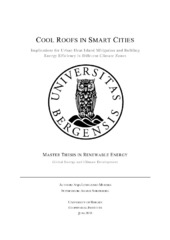| dc.contributor.author | Molnes, Anja Lindgaard | |
| dc.date.accessioned | 2018-10-05T12:16:24Z | |
| dc.date.available | 2018-10-05T12:16:24Z | |
| dc.date.issued | 2018-10-05 | |
| dc.date.submitted | 2018-10-04T22:00:02Z | |
| dc.identifier.uri | https://hdl.handle.net/1956/18619 | |
| dc.description.abstract | As climate change contributes to elevate urban temperatures, undesirable consequences like increased energy consumption, reduced air and water quality and elevated levels of thermal stress for the population continue to threaten the urban environment. It is paramount to address issues related to urban sustainability, environmental performance and energy demand as climate change intensifies and the urban population rapidly continues to grow. Smart city strategies to promote urban sustainability and efficiency are emerging, and mitigation of the urban heat island (UHI) effect through implementation of cool roofs can contribute to reduce these adverse effects by lowering urban temperatures and reducing the cooling loads of buildings and the associated GHG emissions. Through the use of a 1-D bulk urban canopy model combined with an atmospheric layer model, this thesis aims to build a framework for assessing the cool roof mitigation potential on the UHI effect and the associated response in cooling energy demand for the cities of Cairo, Chicago, Delhi, Rome and Singapore. The resulting change in cooling energy demand for space cooling were calculated using degree-days. The results displayed a general reduction in temperature after cool roofs were implemented for all cities, indicating a significant UHI mitigation potential. The magnitude of the UHI effect was reduced by 23-31% after the large-scale introduction of cool roofs, while the temperature-dependent energy demand during the summer period was also reduced, ranging from 10-33% between the different cities. | en_US |
| dc.language.iso | eng | eng |
| dc.publisher | The University of Bergen | en_US |
| dc.subject | radiation budget | eng |
| dc.subject | cooling load | eng |
| dc.subject | energy consumption | eng |
| dc.subject | climate modelling | eng |
| dc.subject | energy balance | eng |
| dc.subject | urban | eng |
| dc.subject | white roofs | eng |
| dc.subject | UHI | eng |
| dc.subject | urban heat island | eng |
| dc.subject | Energy | eng |
| dc.subject | energy demand | eng |
| dc.subject | Smart city | eng |
| dc.subject | environment | eng |
| dc.subject | energy efficiency | eng |
| dc.subject | urban climatology | eng |
| dc.subject | cool roofs | eng |
| dc.subject | sustainability | eng |
| dc.subject | anthropogenic heat | eng |
| dc.subject | degree-days | eng |
| dc.subject | albedo | eng |
| dc.subject | Renewable Energy | eng |
| dc.subject | urban heat island | eng |
| dc.subject | Temperaturregulering | nob |
| dc.subject | Energiressurser | nob |
| dc.subject | Energiøkonomisering | nob |
| dc.title | Cool Roofs in Smart Cities: Implications for Urban Heat Island Mitigation and Building Energy Efficiency in Different Climate Zones | en_US |
| dc.type | Master thesis | |
| dc.date.updated | 2018-10-04T22:00:02Z | |
| dc.rights.holder | Copyright the Author. All rights reserved | en_US |
| dc.description.degree | Masteroppgave i energi | en_US |
| dc.description.localcode | MAMN-ENERG | |
| dc.description.localcode | ENERGI399 | |
| dc.subject.realfagstermer | https://data.ub.uio.no/realfagstermer/c006236 | |
| dc.subject.realfagstermer | https://data.ub.uio.no/realfagstermer/c013031 | |
| dc.subject.realfagstermer | https://data.ub.uio.no/realfagstermer/c007146 | |
| dc.subject.nus | 752903 | eng |
| fs.subjectcode | ENERGI399 | |
| fs.unitcode | 12-44-0 | |
